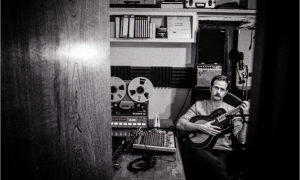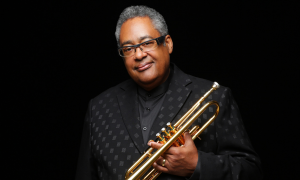Speaking of Alec Wilder (yesterday's post), the composer may have had an inadvertent influence on Artie Shaw's decision to start his Gramercy Five combo in 1940. Forming small jazz groups within big bands was nothing new. Benny Goodman, Bob Crosby and Tommy Dorsey had created them in the 1930s. What was different about Shaw's first sextet was the use of the harpsichord instead of the piano. A year earlier, Wilder had recorded with a harpsichord in his pseudo-jazz octet, and the instrument would play a big role in the sound of Shaw's original Gramercy Five, thanks to the enormous keyboard skills of Johnny Guarnieri.
But the point of this post isn't to do an in-depth examination of Shaw's Gramercy Five, which featured a range of different sidemen over the years. Instead, I simply want to bring to your attention one track recorded by the group in August 1945 that contains early tonal jazz writing. First, some background.
Unlike Benny Goodman, whose forays into bop wouldn't come until the late 1940s, Shaw began to experiment with the form in his second Gramercy Five in 1945. This chamber group featured Shaw on clarinet, Roy Eldridge on trumpet, Dodo Marmarosa [pictured] on piano, Barney Kessel on guitar, Morris Rayman on bass and Lou Fromm on drums. The six tracks recorded by the ensemble were The Grabtown Grapple, The Sad Sack, Scuttlebutt, The Gentle Grifter, Mysterioso and Hop, Skip and Jump.
Grabtown Grapple and The Sad Sack were recorded in January 1945 and are minor-key tunes. While showing some signs of a bop feel, they are fairly traditional small-group swing fare. Grabtown, by the way, is the North Carolina birthplace of Ava Gardner [pictured], Artie's wife at the time.
Six months later, the songs started to take a bit more risk, thanks to Shaw's writing skills. For some strange reason, the summer tracks were credited to Artie Shaw and John Carleton, a pseudonym Shaw used for himself. Why he decided to feature both names on the credit is a mystery, unless he was using the name as a fallback in case the singles didn't sell.
Scuttlebutt, recorded in July and the first of this Shavian series, has more pep and a distinct Basie feel, with the instruments pressed together and running in unison. Despite the bop inklings of Marmarosa and Kessel, Shaw can't seem to pull himself out of the swing mode. In August, Shaw's small-group writing is even more advanced. The Gentle Grifter has a distinctly progressive melody line, but again Shaw's ear for writing contemporary pieces seems more advanced than his playing. Was it Benny Goodman's swing shadow looming over him? Or was Shaw simply unfamiliar with the technique and feel needed to play bop, as Buddy DeFranco noted in a JazzWax interview last week?
Myserioso (not the Thelonious Monk composition, which would come later) is a lumbering blues with a clip-clop beat that gives Shaw a chance to showcase the hot-jazz side of his playing, with hints of Nightmare, Shaw's big band theme. In retrospect, it's a tedious number.
Hop, Skip and Jump is another matter. The final track recorded by the group is an aggressive-paced tune that shifts back and forth between an uptempo blues and a cooler tonal melody line. Excluding the tonal works of Boyd Raeburn's orchestra in 1944 (Eddie Finckel's Duck Waddle, for example), this among the earliest uses of tonal lines in a small-group setting.
Marmarosa's solo on Hop, Skip and Jump is pure bop mounted on top of a swing beat. Eldridge's muted trumpet also leans toward bop. But Shaw continues to play as if it's 1941, though his solo lines are more intricate than in past Gramercy Five solos. It's almost as if Shaw were trying to play his own personal interpretation of bop, which, of course, turns out to be swing. Kessel follows Shaw and also has a bop feel to his solo.
On Hop, Skip and Jump, you hear bop starting to bleed through the swing fabric, exhibiting the form's drawn out harmonies, tonal passages and rhythmic trickery. In fact, the tonal interlude on Hop, Skip and Jump is so radically different and laid back, you wonder what Shaw was thinking and who his influences were. You also wonder whether Shaw's modern writing on this tune had an influence on John Lewis' Milestones of August 1947, Gil Evans' Robbins' Nest of October 1947 and even Neal Hefti's Repetition of December 1947.
Whether Shaw was happy with his bop experiment in the summer of 1945 isn't clear. What we do know is that a few months after Hop, Skip and Jump was recorded, the mercurial Shaw folded his big band and the second Gramercy Five. His next band would be massive, with strings, and wouldn't record until April 1946 for Musicraft.
JazzWax tracks: You'll find all of the tracks mentioned above at iTunes. The Shaw tracks are on Artie Shaw: Summit Ridge Drive and The Complete Gramercy Five Sessions. Interestingly, if you sample Hop, Skip and Jump at iTunes, you'll hear both the bop segment and the tonal interlude that illustrate the points above. Even better, sample the same track on both albums. They feature different sections of the song.
This story appears courtesy of JazzWax by Marc Myers.
Copyright © 2026. All rights reserved.

























